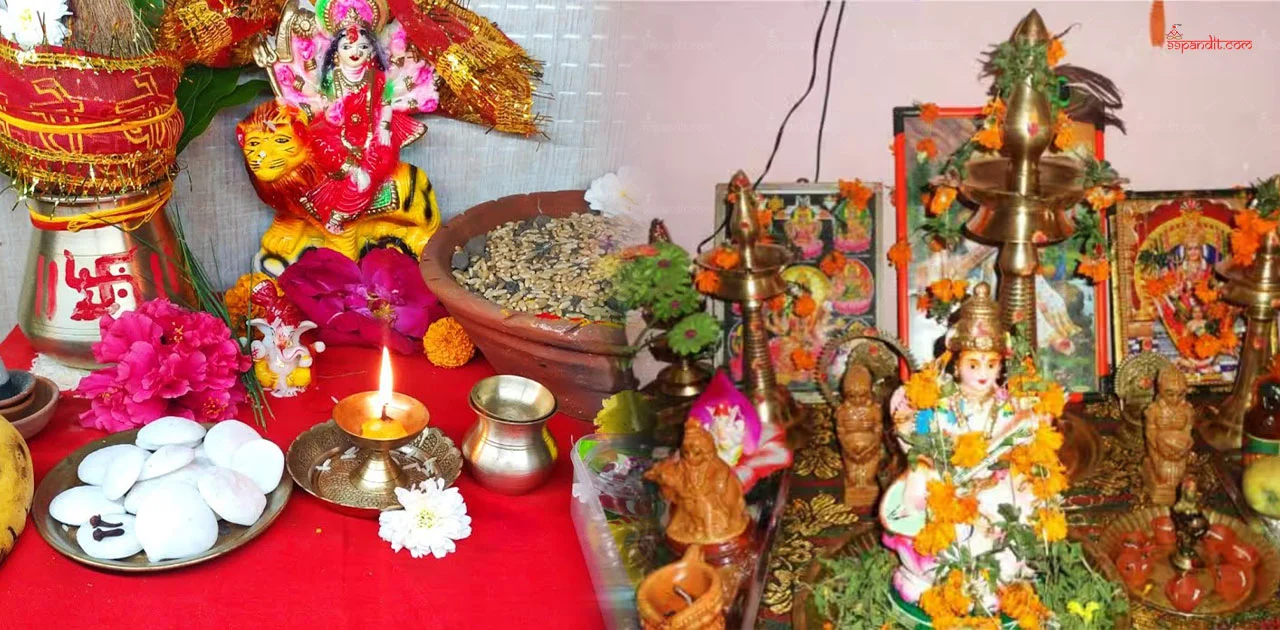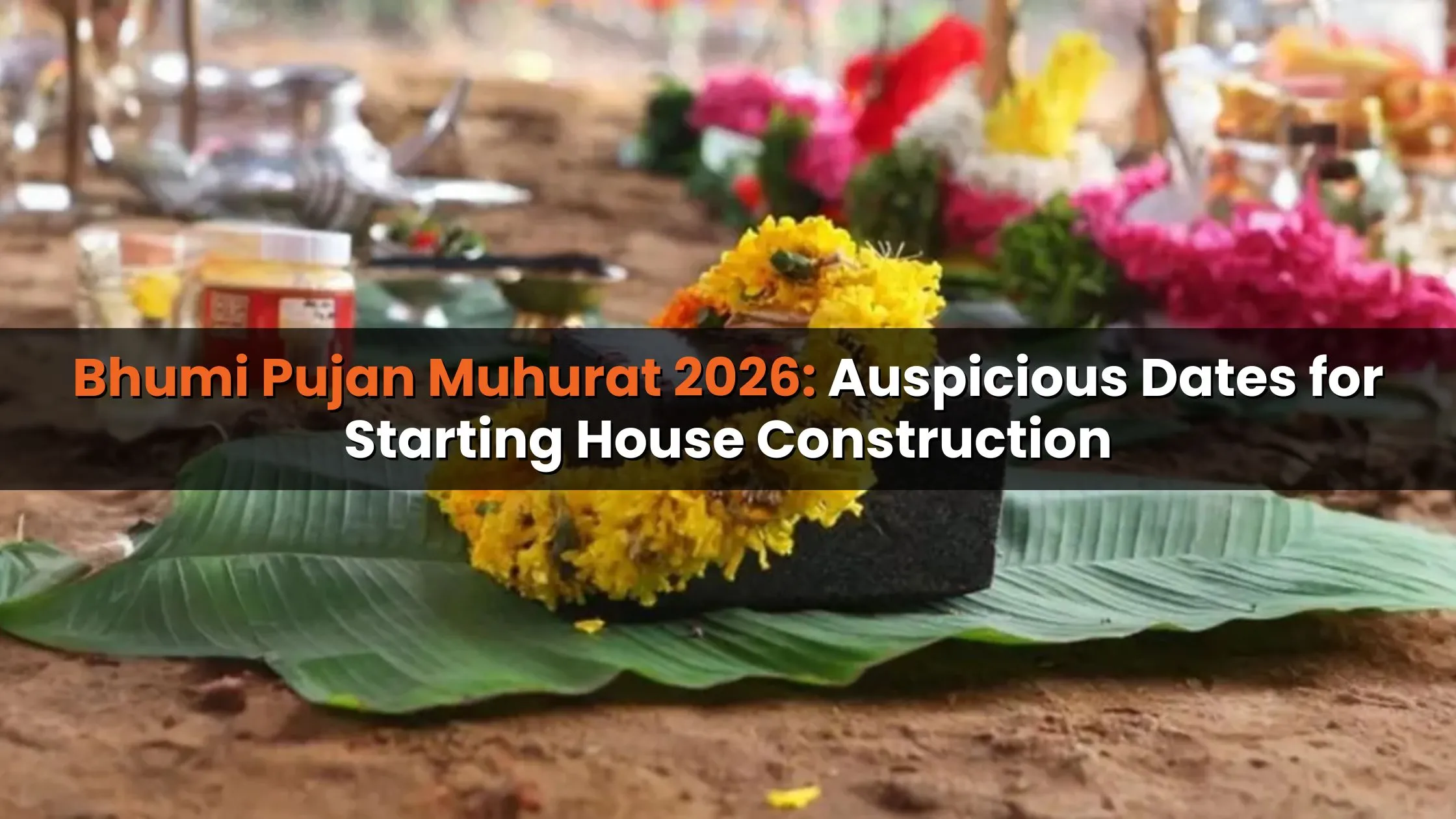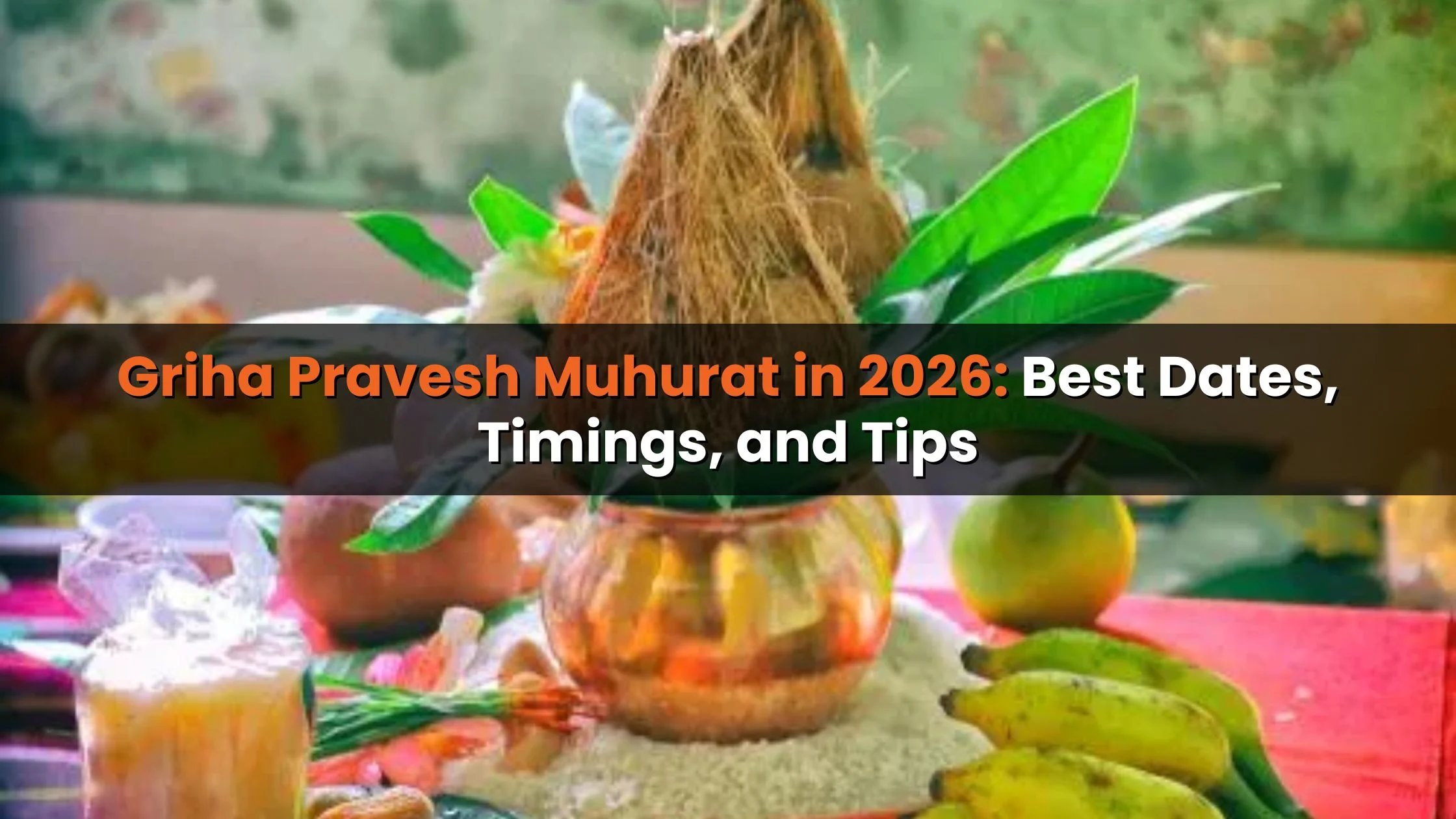Table of Content
- 1. Clean and Organise Your Home Before Navratri
- 2. Correct Placement of Goddess Durga’s Idol
- 3. Decorate Your Entrance With Mango Leaves
- 4. Draw a Swastika at the Main Entrance
- 5. Grow Tulsi Plant in the Northeast Corner
- 6. Use Ghee Lamps
- 7. Place Akhand Jyoti in the Pooja Mandir
- 8. Install a Kalash With Water and Flowers
- 9. Face East or North While Praying
- 10. Use Sandalwood During Pooja
- 11. Best Colour for Pooja Space
- 12. Conch Blowing for Purification
- 13. Use Incense to Cleanse the Air
- 14. Use Cow Urine (Gau Mutra) for Wealth, Health, & Happiness
- 15. Read Devi Bhagwat to Neutralize Planetary Effects
- 16. Offer Water to the Sun
- Avoid Using Certain Materials and Other Vastu Mistakes
- Conclusion
Sometimes, harmony and spiritual energy begin with a clean corner, the right direction, and mindful placement of sacred items. That’s exactly what makes Navratri so special. During this festival, our homes resonate with positivity, devotion, and the blessings of Goddess Durga. But I’ve learned that following Vastu Tips For Navratri can significantly enhance the spiritual energy, peace, and prosperity in my home. Over the years, applying these simple yet powerful Vastu principles has made my Navratri celebrations more vibrant and spiritually fulfilling.
In this guide, I’ll share my personal insights and practical tips on arranging your pooja space, placing idols, and using natural elements to create an auspicious environment during Navratri.
1. Clean and Organise Your Home Before Navratri
Before the festival begins, I always make it a point to clean and declutter my home. According to Vastu, cleanliness is the first step to invite positive energy.
- Remove old, unused items like clothes, magazines, or objects gathering dust.
- Pay attention to common areas like hallways, staircases, and the pooja space.
- Sprinkling water on walls before the festival can purify the space energetically.
A clean and organized environment sets the right tone for rituals and allows spiritual vibrations to flow freely throughout the home.
Also Read: Vastu Tips for Diwali: Bring Wealth and Prosperity into Your Home
2. Correct Placement of Goddess Durga’s Idol
The placement of the Goddess Durga idol is central to maximizing positivity during Navratri. Based on Vastu Tips For Navratri, the idol should be placed in the northeast corner of your home or pooja room.
- Ensure the idol faces north-east, which aligns with auspicious energy and Vastu principles.
- This orientation brings spiritual and material benefits, such as calmness, prosperity, and protection from negative energies.
I always make it a point to keep the main entrance in mind while positioning the idol so that it’s the first divine presence that greets visitors.
3. Decorate Your Entrance With Mango Leaves
One simple but effective Vastu tip I follow is hanging fresh mango leaves on my front door.
- Mango leaves symbolize prosperity, growth, and good health.
- They are associated with Goddess Lakshmi and naturally enhance the positive aura of the home.
- Always use fresh leaves during Navratri for the best impact.
This small decoration instantly uplifts the entrance, making the home feel welcoming and spiritually charged.
4. Draw a Swastika at the Main Entrance
I’ve also found that drawing a Swastika at the main door significantly improves energy flow.
- The Swastika symbolizes protection from negativity and the balance of Shakti (feminine) and Shiva (masculine) energies.
- It ensures smooth energy circulation according to Vastu principles.
Even a simple Swastika drawn with turmeric or kumkum can transform the entrance into a channel for positivity.
5. Grow Tulsi Plant in the Northeast Corner
During Navratri, I always place a Tulsi plant in the northeast corner of my home.
- This sacred plant purifies the surroundings and promotes harmony, peace, and prosperity.
- According to Vastu, the northeast also called the “Karmic” direction—helps reduce the effects of negative karma.
The presence of Tulsi during Navratri acts as a natural energy purifier, creating a calming atmosphere in the house.
6. Use Ghee Lamps
Lighting ghee lamps is a beautiful way to invite positive energy.
- Ghee lamps remove negative vibrations and symbolize purity, warmth, and divine blessings.
- I personally light them daily during Navratri, and the change in the home’s energy is immediately noticeable.
Their soft glow enhances the spiritual ambiance and supports focused devotion.
7. Place Akhand Jyoti in the Pooja Mandir
Another powerful Vastu practice is placing an Akhand Jyoti (continuous flame) in the pooja area.
- It represents the eternal soul and everlasting energy.
- Placing it in the pooja mandir promotes peace, luck, and a deeper spiritual connection.
I always keep mine lit throughout Navratri to maintain a sense of calm and spiritual alignment.
8. Install a Kalash With Water and Flowers
A Kalash filled with water and fresh flowers is a simple yet effective way to attract positivity.
- It symbolizes harmony, wealth, and happiness.
- Placement in the pooja room or kitchen helps eliminate tension and negativity.
I usually place a Kalash in the pooja area and near the kitchen to foster harmony and joy during the festival.
9. Face East or North While Praying
Following Vastu, I ensure that I face east or north while performing Navratri pooja.
- Facing these directions encourages confidence, success, and spiritual blessings.
- Dressing the deities in red during the nine days enhances positive energy.
This alignment strengthens devotion and brings harmony between the mind, body, and spiritual energy.
10. Use Sandalwood During Pooja
Sandalwood is a natural purifier that holds immense importance during Navratri.
- Applying sandalwood paste on idols or devotees enhances spiritual focus.
- Its soothing fragrance helps calm the mind and create a serene environment.
I always use sandalwood tilak during pooja rituals to maintain positivity and devotion.
11. Best Colour for Pooja Space
Colour plays an essential role in Vastu.
- Keep the pooja area painted in green, pink, or yellow to boost positive energy.
- Southeast placement of the pooja space is ideal for channeling Goddess Durga’s blessings.
These colours enhance spiritual vibrations and make the worship area visually and energetically uplifting.
12. Conch Blowing for Purification
I make it a ritual to blow the conch during Navratri.
- Conch shells purify the environment, reduce harmful microorganisms, and remove negative energy.
- Best done in the northeast or east direction for optimal effect.
The sound of the conch immediately lifts the energy and fills the home with positivity.
13. Use Incense to Cleanse the Air
Burning incense sticks made of cow dung or Guggul is a traditional Vastu practice.
- It cleanses the air and elevates positive vibrations.
- Place incense in the northeast or east direction for maximum effect.
I always use incense during pooja to maintain a serene and fragrant environment.
14. Use Cow Urine (Gau Mutra) for Wealth, Health, & Happiness
Spraying Gau Mutra in the house is a traditional method to remove negative energies.
- It is believed to attract prosperity, good health, and happiness.
- I’ve noticed that a light spritz of Gau Mutra during Navratri keeps the home energetically balanced.
15. Read Devi Bhagwat to Neutralize Planetary Effects
Reading the Devi Bhagwat during Navratri is highly recommended.
- Daily recitation helps counteract negative planetary influences.
- Enhances spiritual focus, peace, and protective energy in the home.
I always dedicate time each day to this reading during the festival for inner calm and clarity.
16. Offer Water to the Sun
Offering water to the rising sun each morning is a simple but powerful ritual.
- It brings peace, clarity, and positive energy to the home.
- Doing this daily throughout Navratri enhances spiritual focus and invites blessings.
I make it a point to perform this ritual every day of Navratri to start the day with calmness and positivity.
Also Read: Tulsi Plant Vastu Shastra: Best Placement, Benefits & Tips
Avoid Using Certain Materials and Other Vastu Mistakes
While knowing what to do is important, it’s equally crucial to avoid energy-blocking mistakes:
- Avoid synthetic materials: Plastic, PVC, or artificial items for pooja aasan, idols, or decorations. Use brass, copper, clay, or wood.
- Don’t place idols directly on the floor: Elevate the pooja platform slightly.
- Avoid clutter near the pooja space: Remove old boxes, shoes, or unrelated items.
- Avoid broken or chipped pooja items: Replace cracked idols, diyas, or utensils.
- Avoid dark, damp corners: Ensure proper lighting and ventilation.
- Avoid facing west or south while praying.
- Avoid excessive noise near the pooja area: Maintain calm and serene surroundings.
- Avoid mirrors directly in front of idols: They reflect energy away from the deity.
- Avoid overcrowding the pooja area with decorations.
- Avoid placing toilets or bathrooms near the pooja room.
Extra Tip: Keep the pooja room doors closed during rituals and allow only family members to participate to preserve sacred energy.
Conclusion
Following these Vastu Tips For Navratri has completely transformed the way I celebrate the festival. From correct idol placement and Tulsi plants to ghee lamps and Kalash arrangements, every detail contributes to harmony, prosperity, and spiritual well-being.
Implementing these tips helps create a sacred, energized environment, making Navratri not just a ritual but a holistic celebration of positive energy and divine blessings.
If you want to experience peace, prosperity, and spiritual growth in your home this Navratri, following these Vastu principles is the perfect starting point.










Ans 1. Vastu principles help create a harmonious and spiritually positive environment in the home. During Navratri, following Vastu ensures that the energy flow is optimized, enhancing devotion, prosperity, and peace.
Ans 2. The idol should ideally be placed in the northeast corner of your home or pooja room, facing north-east. This orientation aligns with auspicious energy and Vastu principles.
Ans 3. Mango leaves symbolize prosperity and good health, while a Swastika represents protection and balanced energy. Together, they invite positivity and auspiciousness into your home.
Ans 4. A Tulsi plant in the northeast corner purifies the surroundings and promotes harmony. Additionally, using ghee lamps, an Akhand Jyoti, a Kalash with water and flowers, and sandalwood enhances positive energy.
Ans 5. Facing east or north while performing pooja is considered ideal. These directions encourage confidence, spiritual blessings, and a harmonious flow of energy.
Ans 6. Green, pink, and yellow are considered auspicious and help boost positive energy in the pooja room.
Ans 7. Yes. Avoid synthetic materials, clutter near the pooja area, broken idols or diyas, placing idols directly on the floor, mirrors in front of idols, and facing west or south while praying. These can block or divert positive energy.
Ans 8. Blowing the conch purifies the environment and removes negative energy, while offering water to the rising sun promotes clarity, peace, and spiritual blessings throughout Navratri.
Ans 9. Yes. Daily recitation of Devi Bhagwat neutralizes negative planetary effects, enhances spiritual focus, and creates a protective energy field in the home.
Ans 10. These practices can be implemented throughout the nine days of Navratri to maximize positive energy, harmony, and spiritual blessings in your home.